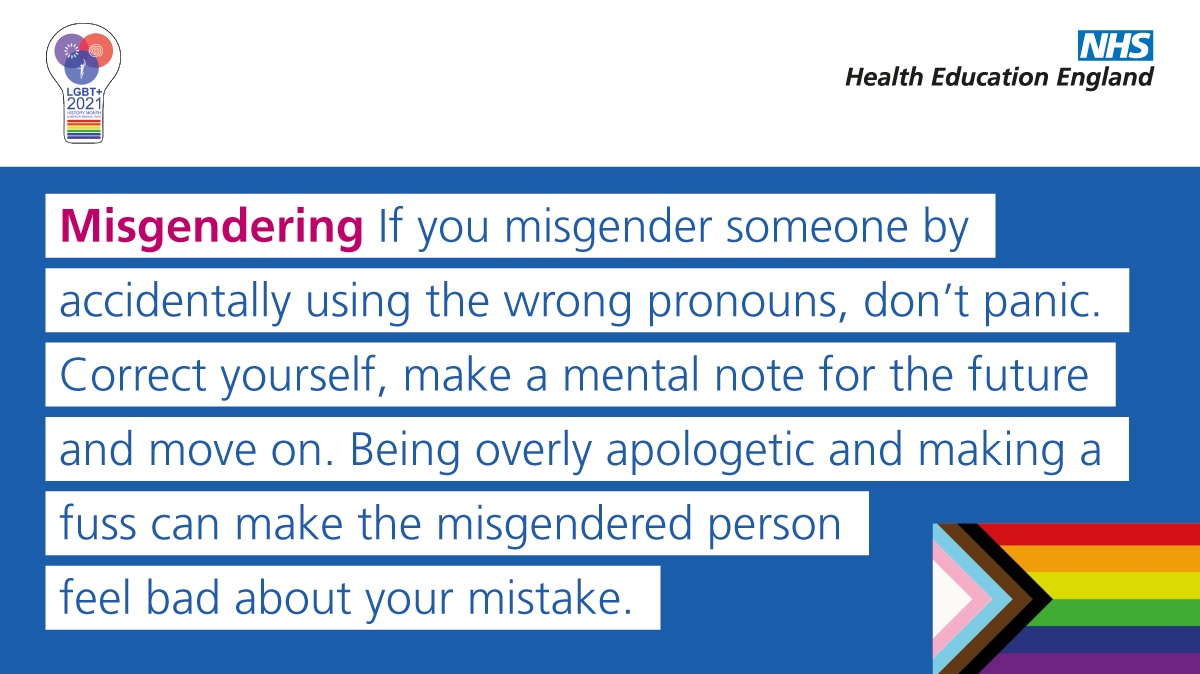
 This is a brief introduction to speaking with, and about, members of the LGBTQIA2S+ community. It’s a big, diverse community and the language is always changing. Here is a brief crash course on common words and language you'll hear to refer to this community!
This is a brief introduction to speaking with, and about, members of the LGBTQIA2S+ community. It’s a big, diverse community and the language is always changing. Here is a brief crash course on common words and language you'll hear to refer to this community!
This is by no means a comprehensive list and we've linked a few other resources such as GLAAD's reference guide, LGBTQ+ Commission's Glossary, TransLifeLine's Glossary, or The Safe Zone Project's Glossary of Terms. As with everything, please look over all these resources with a critical eye -- some of these definitions might not fully represent how these words are used and incorporate everybody's varied relationships with words and identities.
agender (adj.) – Describes a person who identifies as having no gender.
aromantic or aro (adj) – A person who generally does not experience intimate amorous or passionate feelings for others, and may not be interested in pursuing romantic relationships. Note, however, that aromantic people are perfectly capable of experiencing platonic and familial love, as well as enjoying sexual intimacy.
asexual or ace (adj.) – Experiencing little or no sexual attraction to others and/or a lack of interest in sexual relationships/behavior. Asexuality exists on a continuum from people who experience no sexual attraction or have any desire for sex, to those who experience low levels, or sexual attraction only under specific conditions. Many of these different places on the continuum have their own identity labels (see demisexual).
bisexual (adj.) – The potential to be attracted - romantically and/or sexually - to people of more than one sex and/or gender, not necessarily at the same time, not necessarily in the same way, and not necessarily to the same degree.
cisgender/cis [ sis-jen-der / sis ] (adj.) – A term for people whose gender identity matches the sex or gender they were assigned at birth. This is commonly referred to as the opposite of "transgender" and was created by transgender people who felt that not having a word to describe non-transgender people further othered the transgender community as different from the norm. Also referred to as "cis."
demisexual (adj.) – An identity term within asexuality that is often defined as those who experience sexual attraction only after a significant emotional bond has been built. This is distinctly different from those who want to engage in sexual activity only after building a connection with other people, as it pertains to attraction and not the desire to engage in sexual activity.
gay (adj) – An identity term for someone who experiences same-gender attraction, and sometimes refers to someone who only experiences same-gender attraction. Commonly used to describe people who identify as men or masculine of center who are attracted to some other men. Not all people who use this term are men, though the term historically has been used as such; it is now often used to describe any same-gender attraction, and is also used by women and nonbinary people.
gender fluid (adj.) – Describes a person whose gender identity is not fixed. A person who is gender fluid may always feel like a mix of the two traditional genders, but may feel more one gender some days, and another gender other days.
genderqueer (adj.) – Either a stand-alone identity that describes those with a gender outside of the binary, or as an umbrella term to describe a spectrum of non-binary gender identities. When serving as a stand-alone identity, it can encompass individuals who identify as both a man and a woman; neither man nor woman; moving between two or more genders; or having an overlap or blur of gender and orientation.
intersex (adj.): An umbrella term used to describe someone born with internal and/or external sexual anatomy that doesn’t fit the typical expectations of the male/female binary. People who are intersex may hold any number of identities with regard to their sexual orientation, gender identity, and gender expression.
lesbian (noun & adj.) – Commonly used to describe people who identify as women or feminine of center, whose attractions are to some other women. Some nonbinary people who were assigned female at birth use this term to describe their attraction to women, despite not identifying or not solely identifying as women.
minority stress (noun) – Chronic stress faced by members of stigmatized minority groups. Minority stress is caused by external, objective events and conditions, expectations of such events, the internalization of societal attitudes, and/or concealment of one’s sexual orientation.
pansexual (adj) – Commonly used to describe someone who is attracted to people regardless of gender or to all or many genders of people. This term is sometimes specifically used to be inclusive of attraction to individuals across the gender spectrum.
polyamory (adj.) – Describes a person who has or is open to having more than one romantic or sexual relationship at a time, with the knowledge and consent of all their partners. Sometimes abbreviated as poly.
queer (adj) – An umbrella term used to describe people who are not heterosexual and/or cisgender. “Queer” has been reclaimed by LGBTQ communities since its historical use as a slur against LGBTQ people and is now widely used among LGBTQ people and in institutional and formal settings. Due to its historical use as a derogatory term, and how it is still used as a slur many communities, it is not embraced or used by all LGBTQ people. Many people appreciate the way that queer can be used a term to include everyone in the LGBTQ+ community, without listing letters of the acronym (LGBTQ), which leaves key groups of people unlisted.
QPOC (noun) – An acronym that stands for Queer Person of Color or Queer People of Color.
transgender (adj.) – People whose gender identity differs from the gender they were assigned at birth. Transgender can be both a standalone identity or an umbrella term that encompasses many different gender identities, including nonbinary and gender-expansive identities. “Trans” is often used as shorthand for transgender.
two-spirit (noun) – A modern, pan-Native American term used by some Indigenous communities in the United States to describe queer and/or gender non-conforming people, replacing the inaccurate and often degrading phraseology imposed on gender-variant Indigenous peoples by white colonizers. Note that the term is not synonymous with western concepts like “transgender” or “queer”—it can mean many things depending on an individual’s culture or personal identity.
These terms may have been used in the past but are now considered outdated or offensive. As with all things, if a member of the community chooses to self-describe themselves using any of these words, it is important to respect their autonomy and identity. Again, this is by no means a comprehensive list so it is essential to stay curious and do your own research!
|
Outdated Term |
Use this instead! |
|
|
|
|
|
|
|
|
|
|
|
|
|
|
|
|
|
A note on the LGBTQ+ initialism: there is no single 'best' initialism or term to refer to the LGBTQ+ community. The language and initials that members of the community uses varies from person to person and often many people use the terms interchangeably. Every person has a different relationship with their identity and how it fits into the larger umbrella of the community. There is no singular option that everyone agrees on and that's okay! Check out the article "Should I use LGBT, LGBT+, LGBTQ, LGBTI, LGBTQIA or something else?" for a more detailed explanation.
For the purposes of this guide, we will be using a variety of terms including: queer, LGBT, LGBTQ+, LGBTQIA+, and LGBTQIA2S+ to refer to members of this community. The language queer folks use to describe themselves is always evolving and changing and we do our best to be as inclusive as possible throughout this guide.
There are many elements to queerness, including different kinds of attractions and orientations! For more information about the difference between gender identity and sexuality, check out our “Trans Umbrella” tab!
 There are many different types of attractions including sexual, romantic, aesthetic, sensual ( the desire to interact with others in a tactile, non-sexual way), emotional, and intellectual! We are going to focus on romantic and sexual attractions and how they relate to an individual’s romantic and sexual orientations.
There are many different types of attractions including sexual, romantic, aesthetic, sensual ( the desire to interact with others in a tactile, non-sexual way), emotional, and intellectual! We are going to focus on romantic and sexual attractions and how they relate to an individual’s romantic and sexual orientations.
Sexual orientation refers to the gender(s) that an individual may be sexually attracted and how they choose to express their sexuality (ex: asexual, bisexual, heterosexual, etc). Romantic orientation describes an individual’s pattern of romantic attraction based on a person’s gender(s) regardless of one’s sexual orientation (ex: aromantic, biromantic, heteroromantic, etc).
Many people assume that romance and sexuality must be intertwined – while they might be related for lots of people, many people’s romantic and sexual orientations may not align and that’s okay! For example, a person might be sexually attracted to all genders (bisexual and/or pansexual) but only be romantically interested in people of the same gender (homoromantic). Another person might experience no sexual attraction (asexual) and only experiences romantic attraction towards someone after they’ve established a strong emotional bond (demiromantic).
For a more comprehensive guide about asexuality and aromanticism, check out UNC’s “Exploring Identities: Aseuxality, Attraction, and Romantic Orientation” page.
Sex Assigned at Birth: The assignment and classification of people as male, female, intersex, or another sex based on a combination of anatomy, hormones, chromosomes. It is important we don’t simply use “sex” because of the vagueness of the definition of sex and its place in transphobia. Chromosomes are frequently used to determine sex from prenatal karyotyping (although not as often as genitalia). Chromosomes do not always determine genitalia, sex, or gender.
Gender Identity: A person’s experience of their own gender; a person’s innermost concept of self as masculine, feminine, a blend of both, another gender(s), or none. This is not always congruent with biological sex or gender assigned at birth.
Gender Expression / Presentation: The physical manifestation of one’s gender identity through clothing, hairstyle, voice, body shape, etc. Many transgender people seek to make their gender expression (how they look) match their gender identity (who they are), rather than their sex assigned at birth.
Two useful metaphors for helping understand gender and sex are the Gender Unicorn and Trans Umbrella. The Gender Unicorn encompasses a person’s gender identity, gender expression, sex assigned at birth, and physical and emotional attraction and where an individual falls on each of the spectrums. There are no wrong answers and your answers might change as you grow and change throughout your life! Your dots don’t have to be connected or related and you get to define what each element means to you.
The Trans Umbrella encompasses terms that are used to describe a large range of concepts or experiences in simplified terms. For example, “painting” is an umbrella term that can be used to talk about oil paintings and watercolours, detailed brushwork to splatter art, and even changing the colour of a house.
Umbrella terms are an often imperfect but helpful solution to trying to talk about a wide range of experiences that are closely related in some ways, but very different in others. No two trans people will have the same experience of being trans, but we have similar experiences that may not be shared with cis people.
Trans and gender diverse people are also a socially and legally marginalized population, and coming together under these umbrellas of identity is an important way of advocating for ourselves and each others’ rights despite the differences we may have.
Inclusive use, sometimes referred to as “Gender-neutral" restrooms are typically a single-stall, lockable restroom available to people of all genders and sexes. Gender-neutral bathrooms provide a safe, private facility for transgender, genderqueer, and gender non-conforming people, families with children, and people with disabilities who may need assistance. Single-stall restrooms also more easily meet the accessibility regulations of the Americans with Disabilities Act (ADA).
A ccording to the Sylvia Rivera Law Project, “trans and gender variant people face severe access problems when it comes to sex-segregated facilities like restrooms, locker rooms, shelters, in-patient drug treatment facilities, prisons and jails, etc.”
ccording to the Sylvia Rivera Law Project, “trans and gender variant people face severe access problems when it comes to sex-segregated facilities like restrooms, locker rooms, shelters, in-patient drug treatment facilities, prisons and jails, etc.”
Everyone deserves equal access to public facilities. No one should have to fear violence or harassment as a result of entering these facilities. This idea dates back to the civil rights movement when activists fought to end segregation of public facilities based on race. To get an idea of what gender-nonconforming people experience when they enter a restroom, try going into the opposite sex’s restroom, or looking for a gender-neutral restroom to use in a public space.
Over the past several years, state legislators across the United States are advocating for policies that would prohibit transgender students and people from using bathrooms that align with their gender identity. These bills, known as "bathroom bill" perpetuate violence and discriminations against trans people, particularly trans women and non-binary people. Purporting to protect women and students from "sexual predators" -- these bills are rooted in transphobia and there is no research that these bathrooms actually protect women or marginalized gender people.
While Maine has historically sided with anti-discrimination bills and protected transgender folks, trans people still face harassment and are often anxious to use a bathroom that aligns with their gender identity, if one is even available. For information on finding gender neutral bathrooms, check out our "USM & Maine Resources" under the "Resources for Queer & Questioning Folks" tab.
Quick definition: A pronoun is a word that refers to either the people talking (I or you) or someone or something that is being talked about (like she, it, them, and this). Gender pronouns (he/she/they/ze etc.) specifically refer to people that you are talking about.
The most common pronouns are she/her/hers and he/him/his. Some examples of gender-neutral pronouns include:
they/them/theirs – Yes, you can use ‘they’ to indicate a singular person. No, you cannot use grammar as an excuse to be transphobic.
| Examples of Pronouns! | How to Use Guide |
 You can’t know someone’s pronouns or gender identity by just looking at them! About one quarter of LGBTQ+ youth use pronouns or pronoun combinations (ex: they/she, ze/he, etc) outside the binary construction of gender.
You can’t know someone’s pronouns or gender identity by just looking at them! About one quarter of LGBTQ+ youth use pronouns or pronoun combinations (ex: they/she, ze/he, etc) outside the binary construction of gender.
Knowing and using a person's correct pronouns and chosen name fosters inclusion, makes people feel respected and valued, and affirms their gender identity. It also reduces depressive symptoms, suicidal ideation, and suicidal behaviour.
If you don’t know someone’s pronouns, while you might want to ask them, some people are not ready to come out or may not feel comfortable sharing their pronouns with you. Instead, introduce yourself and your pronouns. Something like, “Hi, I’m Mira and use she/they pronouns.” This is the best way to encourage other people to feel safe sharing their pronouns.
Note! It is not “preferred pronouns” but rather just someone’s pronouns. Saying “preferred” makes it seem like using someone’s pronouns is optional when, in reality, using a person’s pronouns is the most basic need they have to feel safe and to exist in public spaces.
We all make mistakes and that’s okay! Whether you realize your mistake or someone corrects you, be sure to apologize and then move on. While it might be tempting to make excuses or justifications for misgendering someone, it puts the onus on the person you misgendered to comfort you and accept your apology.
If you hear someone misgendering another person, gently correct them without further embarrassing the person who was misgendered. An example, “Ben uses they/them pronouns,” and then moving on. Depending on how the person who was misgendered feels, it might be helpful to check in with them later and offer support. Follow their lead and listen to what their needs are from you: everyone has different needs in different situations and what one person might need or appreciate could be different for another person or different situation.

Practice using pronouns: https://www.practicewithpronouns.com/#/?_k=5r9pd4